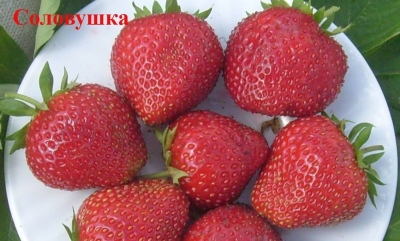
- Authors: All-Russian Institute of Selection and Technology of Horticulture and Nursery, Aitzhanova S.D.
- Taste: good
- The size: large
- Weight: up to 50 g
- Yield rate: high
- Yield: more than 0.8 kg per bush
- Ripening terms: medium
- Advantages: long-term storage
- Appointment: fresh consumption, processing (juice, jam, jam, etc.)
- Description of the bush: vigorous, compact, round
The strawberry variety Solovushka was bred about 15 years ago at the All-Russian Institute of Selection and Technology for Horticulture and Nursery by breeder Svetlana Dmitrievna Aitzhanova. Since then, it has enjoyed constant success with gardeners due to its yield, excellent taste and frost resistance.
Description of the variety
Strawberry Nightingale is characterized by vigorous, but compact, rounded bushes. Leaves are densely carved, have a bright green color. Each plant of this variety reaches a height of 45 cm, a diagonal of 55 cm. There are 6-9 peduncles on an annual bush, and in subsequent years their number reaches 20. Refers to non-repair varieties.
Ripening terms
Nightingale belongs to varieties of medium ripening periods. The first ripe berries appear in mid-May, and mass fruiting occurs in June. It should be remembered that due to thin peduncles, the berries can end up on the ground, therefore, the soil should be mulched before the main ripening. This variety is often cultivated on a special material.
Yield
Nightingale strawberries are high-yielding varieties. It is easy to harvest 500 g of berries from one plant during the first year. In the following years, the yield indicators are more than 800 g of berries. Fruiting begins immediately in the year of planting. The berries ripen together and are not afraid of cool weather.
Berries and their taste
For the fruits of the Solovushka variety, a rich red color with a slight sheen is characteristic. The berries are round-conical in shape, up to 50 g in size, have a dense and juicy flesh. The nightingale has good taste, it has a sweet and sour taste and the smell of wild strawberries. Berries of this variety are used both fresh and for all kinds of preparations (juices, preserves, jams). The fruits have an average shelf life and during transportation they also show average results.
Growing features
Nightingale belongs to the uncomplicated varieties, suitable even for novice gardeners. Strawberries are winter-hardy, do not require shelter from the cold. It is characterized by high drought resistance, well tolerates a drop in temperatures during ripening. The Nightingale variety is resistant to common diseases and pests of strawberries. But it requires mandatory mulching with straw because of the berries strongly leaning to the ground.




Site selection and soil preparation
This variety prefers fertile light to medium soil with addition of river sand and peat. The site must be sunny, no shading is required for the berries. Young plants are planted in spring in April-May or at the end of summer.
Two weeks before planting in August, it is necessary to prepare the beds, and for spring planting, this is done in the fall. Compost should be added to the soil - 10 liters per 1 m2 or complex mineral fertilizers - 50 g per 1 m2. Remember that when planting, the rosettes of young bushes should not be deeply buried. A distance of 35-55 cm between plants and 45-65 cm between rows should be observed.

Pollination
When growing in open ground, strawberries are pollinated by Nightingale naturally. With the help of insects, wind and rain, pollen from male flowers gets on female flowers. When grown in a greenhouse, pollination is carried out using a fan instead of wind, or using a brush to move pollen from plant to plant.

One of the important techniques in strawberry care is feeding. Regular fertilization guarantees a rich harvest. There are several different ways to feed strawberries, and each of them is designed for a specific period of plant development. During flowering, fruiting and after it, feeding should be different.

Diseases and pests
Despite the general immunity to diseases, the variety can be affected by gray rot and leathery late blight. The occurrence of gray rot is most often promoted by high humidity, the fruits are covered with a gray bloom and rot. Mandatory treatment of plants with Trichoderma Veride is required. With late blight, the leaves stop growing and dry out, this is often facilitated by long-term, more than 4 years, cultivation of strawberries in one place. In the fight against late blight, the drug "Quadris" has proven itself well.

Strawberries are often subject to many dangerous diseases that can seriously undermine its condition. Among the most common are powdery mildew, gray mold, brown spot, anthracnose, and verticillosis. Before buying a variety, you need to inquire about its disease resistance.
Reproduction
Strawberry variety Nightingale can be propagated by seeds, mustaches, and by dividing the bush. The first method is rarely used, as it requires a lot of effort.
When breeding with a mustache, you need to select the most powerful mustache, remove the rest. After the formation of roots on the outlet, the mustache should be dug in, without cutting it off from the main bush. In August, the overgrown new bushes are separated from the mother plant and transplanted to a permanent place of growth. Remember that a feature of the Solovushka variety is a large formation of whiskers in the first year of planting, therefore it is recommended to propagate plants in this way during this period.
The division of the bush is carried out by carefully digging a healthy plant 1-3 years old. A sharp knife is disinfected in a solution of potassium permanganate and then the bush is divided into 3 parts. Each new plant must have a well-developed root system. After that, young strawberries are immediately planted in the holes.



















































































